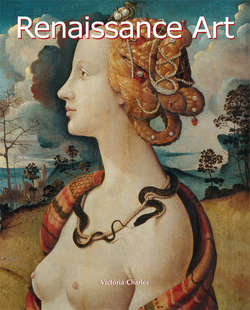Читать книгу Renaissance Art - Victoria Charles - Страница 2
На сайте Литреса книга снята с продажи.
Introduction
ОглавлениеMichelangelo Buonarroti, David, 1501–1504.
Marble, h: 410 cm.
Galleria dell’Accademia, Florence.
In the middle of the fourteenth century a cultural transformation took place, a transformation that was initiated in Italy and was called Rinascimento there, and was subsequently known as Renaissance in France. It separated the Middle Ages from the Modern Age and was accompanied by Humanism and the Reformation. This development was a return to the classical arts of Greek and Roman Antiquity. It led to intensive studies of the long forgotten poets, to an enthusiasm for sculpture and for the numerous remains of architecture, even if they only existed as ruins.
Equally important for this development was the development of technology and sciences, which began in today’s Scandinavia, as well as the Netherlands and later in Germany.
In Italy, it was initially architecture which fell back on classical ideals and, a little later, it was sculpture which sought a closer bond with nature. When the architect and sculptor, Filippo Brunelleschi (1377 to 1466), went to Rome to excavate, study and measure the remains of antique buildings, he was accompanied by the goldsmith and sculptor Donatello (around 1386 to 1466). The sculptures found during that time and during later excavations fired the enthusiasm of the sculptors, which, at the end of the fifteenth century was powerful enough to lead Michelangelo to bury one of his pieces of work in the ground, so that shortly afterwards it could be dug up as being “genuinely antique”.
The Italian Renaissance lasted for approximately two hundred years. The early Renaissance is classed as belonging to the years between 1420 and 1500 (the Quattrocento), the heyday of the Renaissance ended about 1520, and the late Renaissance, which turned into Mannerism, came to a close in around 1600 (the Cinquecento). Baroque art (roughly translated as “quirky, eccentric”) developed as an imperceptible transition from the late Renaissance as a further development in Italy and in some other countries and was occasionally seen as a deviant and decadent, but now and again as a higher form of development, dominating until the end of the seventeenth century. After the Renaissance crossed the Alps into Germany, France and the Netherlands, it took a similar course and is classified the same way as in Italy.
Lorenzo Ghiberti, Door of Eden, 1425–1452.
Gilded bronze, 506 × 287 cm.
Baptistery, Florence.
Donatello, David, c. 1440–1443.
Bronze, h: 153 cm.
Museo Nazionale del Bargello, Florence.
